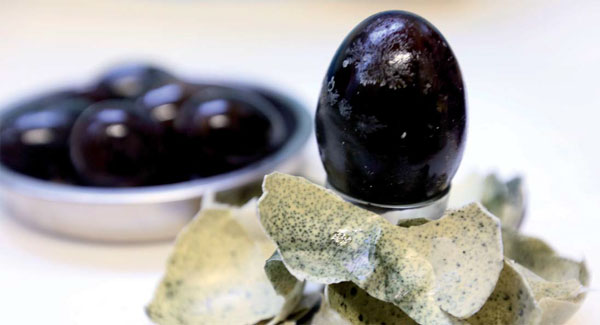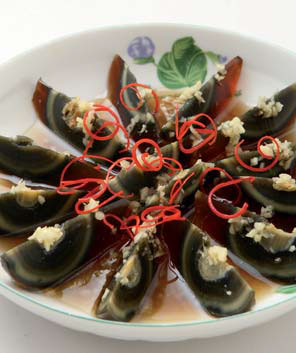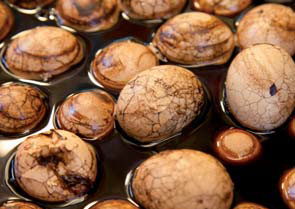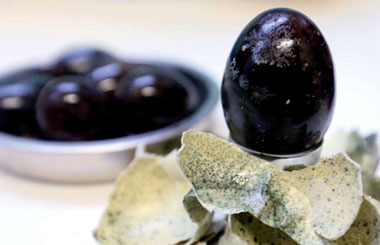Eggs 101 the Chinese way
Updated: 2016-05-20 08:22
By Pauline D Loh(China Daily Europe)
|
|||||||||
Century eggs are carefully cured for several weeks to several months so that the albumen solidifies into a dark, transparent, gel-like semisolid while the yolk hardens slightly on the outside but remains molten in the center. Photos Provided to China Daily

Editor's note: To understand China you have to sit down to eat. Food is the adhesive that holds the Chinese social fabric together. In the face of increasing globalization, food is also one of the last strong visages of community and culture.
Which came first? The chicken or the egg? If you ask a Chinese chef, he'll answer you in an instant the egg. He won't be wasting any time deliberating the philosophical conundrum because he'd be too busy brewing his tea eggs, or checking the progress of his urn of century eggs.
In the Chinese kitchen, fresh eggs are a pantry staple, but you'll also find salted eggs and pickled eggs like the infamous black century eggs that have Westerners shuddering on sight.
They are actually no more fearsome than potted eels or ripe blue cheese, and foolhardy participants who stuff whole eggs into their mouths on television episodes of Bizarre Foods or Extreme Food Adventures really deserve to have their palates pickled.
There is an art to eating century eggs, as any Chinese child will tell you.
First, let's debunk the myth. They have not lain forgotten for 100 years, despite the name. Instead, pidan, as they are known in Chinese, are carefully cured for several weeks to several months so that the albumen solidifies into a dark, transparent, gel-like semisolid while the yolk hardens slightly on the outside but remains molten in the center.
There are strict culinary standards on what makes a pidan a gourmet experience.
Pidan are always eaten with condiments. They may be served with sweet slices of pink pickled ginger, doused in sesame oil and vinegar, or smothered in minced garlic or chopped cilantro leaves.
These pickled eggs, so feared by the West, are treasured enough to be served at banquets in China, always daintily slivered and decorated.
The most common raw ingredient for pidan is duck eggs, valued for the size of the yolks and the generosity of the egg white. However, chicken or quail eggs are also used, but more for novelty rather than need. A good century egg often has a snowflake pattern on the outside of the white, an indication of a well-cured egg.
Its fearsome color is the result of a chemical reaction with the curing mix usually wood ash, salt and rice husks mixed with clay or lime.
Another popular staple is the salted egg, a pure white delight that is as visually attractive as its cousin is not.
Eggs from either chicken or duck are carefully wiped clean with Chinese liquor and placed in bottles of saturated brine. After a month to several weeks, the whites would have thoroughly absorbed the salt, and the yolks hardened into little golden globes.
Salted eggs are most often boiled and then split and eaten straight from the shell. They are also used for cooking. The salted egg yolks are vital ingredients in many seasonal foods, including the rice dumplings eaten during the Dragon Boat Festival and the sweet moon cakes during Mid-Autumn festival.
Salted or cured, it is the rare Chinese kitchen that doesn't have a store of several century eggs or a carton of salted eggs. They are good when unexpected guests drop in, or when market day is still several mornings away and the dishes on the table need augmenting.
Fresh eggs have special meaning to the Chinese, and many rural families still keep chickens so they have a steady supply. Eggs are auspicious food, a symbol of fertility, of longevity, of new life.
The birth of a child or a grandchild is celebrated with the delivery of hard-boiled eggs to friends and relatives, often dyed a brilliant red in honor of the occasion.
Eggs are also a part of the bride's dowry, sent by her family on the wedding day to her husband's home as a sign of her potential fertility. They reciprocate with a gift of live chickens.
Birthdays are also marked with noodles and eggs all over China, and even as an ethnic Chinese growing up abroad, I remember my grandmother making a bowl of vermicelli for me with a large egg on top, dyed bright red, of course.
On the banks of the West Lake in Hangzhou, tea-infused eggs are sold as snacks and they are made with the region's famous longjing, or Dragon Well, green tea. Then there are always the delicious steamed custards both savory and sweet.
Savory steamed eggs are a Chinese specialty, with the most delicious made with equal parts beaten eggs and rich meat stock. The dish is placed over barely simmering water to gently steam and the result is a velvety smooth custard that slips down the throat. There are many variations to the theme, and the smooth custard may hide an inner layer of seasoned minced pork, fish, whole prawns, or even tofu. The finished custard is garnished with a sprinkling of chopped scallions, and drizzled with soy sauce and sesame oil.
You cannot mention custard without talking about the delightful desserts from Guangzhou - the custard filled tarts, sweet milky custards, steamed eggy sponges and those breakfast classics from Hong Kong, egg-battered French toast drizzled with condensed milk.
Eggs are also indispensable for the thickening of those rich Chinese broths like the hot and sour soup full of shredded meat, bamboo shoots, wood-ear mushrooms and with a beaten egg dropped in at the last moment.
They are also used in batters for deep-fried foods, or to enrich gravies for braised meats.
In the Chinese kitchen, eggs come first. Every time.
paulined@chinadaily.com.cn
How to serve century eggs

Most century eggs come encased in a thick coating of yellow clay mixed with rice husks. Gently rub off the clay. If it's too hard, a brief soak in water will help. Once the mud coat is off, rinse the shell clean and crack it like a hard-boiled egg. Be gentle, as the egg white can be fragile.
To slice the egg, I normally use a thin thread, or unwaxed, plain dental floss without mint. It's easier than using a knife because the yolks tend to stick.
Lay out the slivers of egg on a platter and prepare the garnishes.
If you can get them, sweet pickled ginger slices go very well with the eggs. You can buy these at Chinese or Japanese grocery stores. These are the same ginger slices served with sushi.
Mix together 2 tablespoon black vinegar (balsamic vinegar works) and 1 tablespoon sesame oil. Mix into an emulsion and drizzle over the eggs. Top with a scattering of toasted sesame seeds and some freshly chopped cilantro leaves. Enjoy!
How to make tea eggs

Brew a pot of tea. You can use any Chinese tea, but a dark tea like pu'er will taste stronger than green tea.
Place the tea and tea leaves in a pot, add a piece of star anise, a stick of cinnamon and either some cloves or cardamom. Add soy sauce and enough water for the liquid to come halfway up the pot.
Wash about 10 eggs and place them in the pot to boil. After 15 minutes, remove the eggs and gently tap them to crack the shells. Turn off the heat and return them to the infusion. You want a marbled effect.
I find the flavors and colors improve if you also break the membranes so the tea infusion can penetrate.
Now, you must wait. Allow the eggs to soak in the tea sauce for a few hours, preferably overnight. You'll be rewarded for your patience with the most flavorful hard-cooked eggs you have ever eaten.
You can reuse the tea sauce to cook more eggs when the first batch is finished, but remember to either add more tea or soy sauce to adjust the seasoning.
Today's Top News
Still learning
EgyptAir denies finding wreckage of missing flight
China urges US to halt close surveillance
Debris found in sea in search for missing MS804
LinkedIn matches refugees with jobs
Top legislator foresees bright future for SAR
UN climate talks resume to write 'rule book'
Internet regulations: From the US to Australia
Hot Topics
Lunar probe , China growth forecasts, Emission rules get tougher, China seen through 'colored lens', International board,
Editor's Picks

|

|

|

|

|

|







